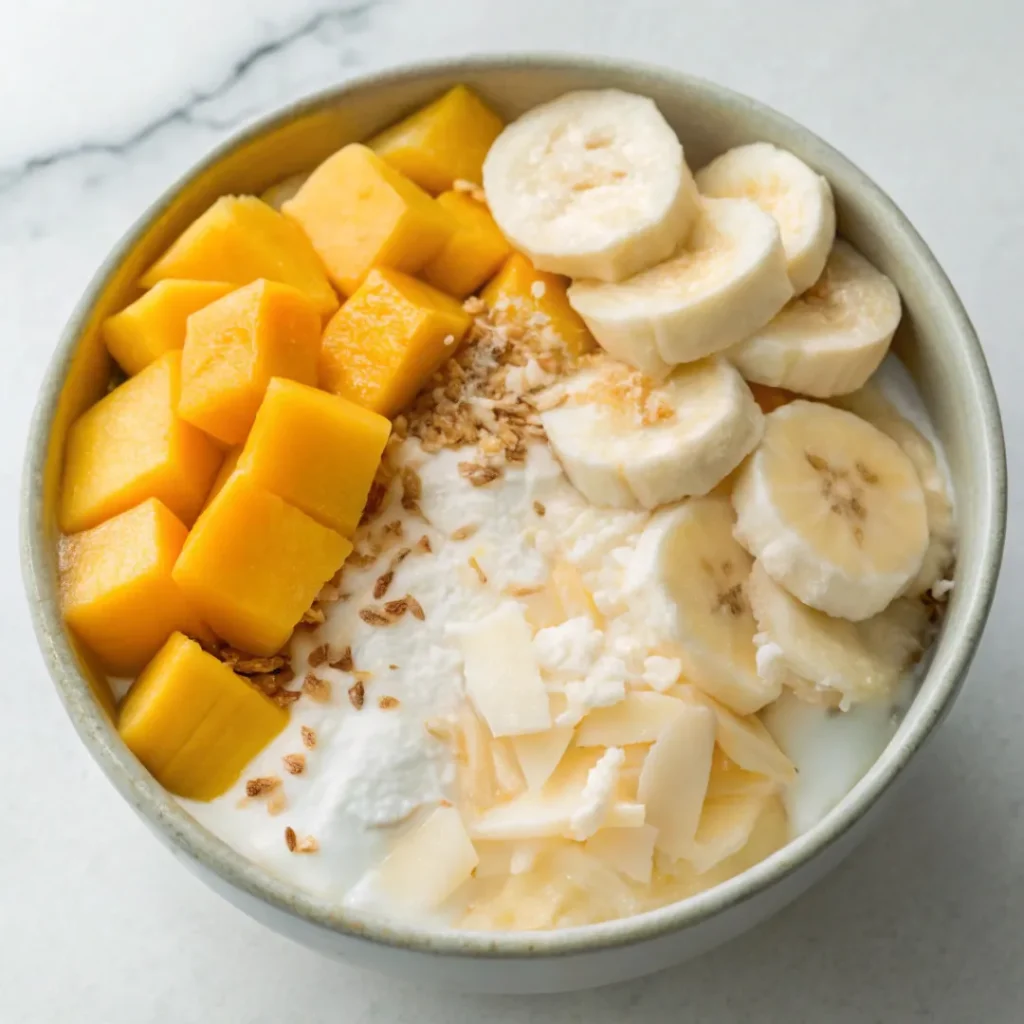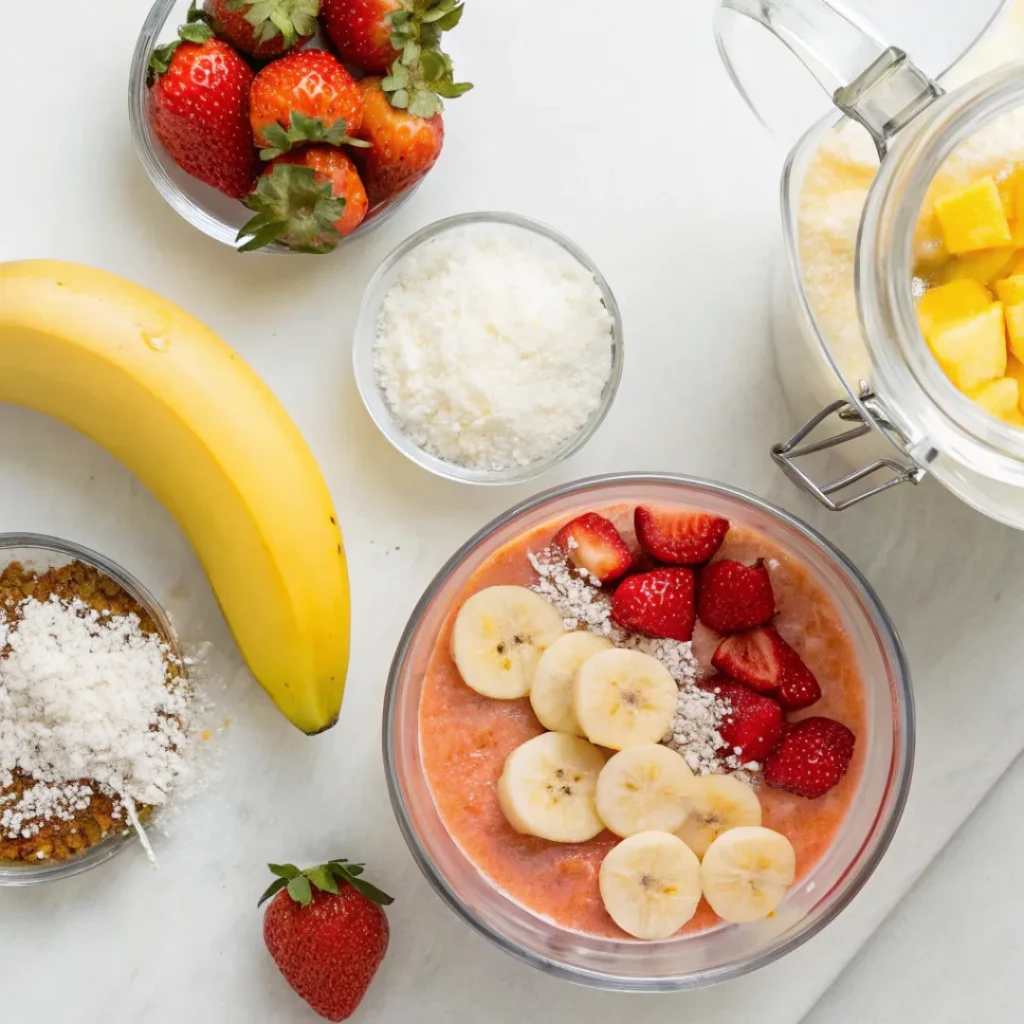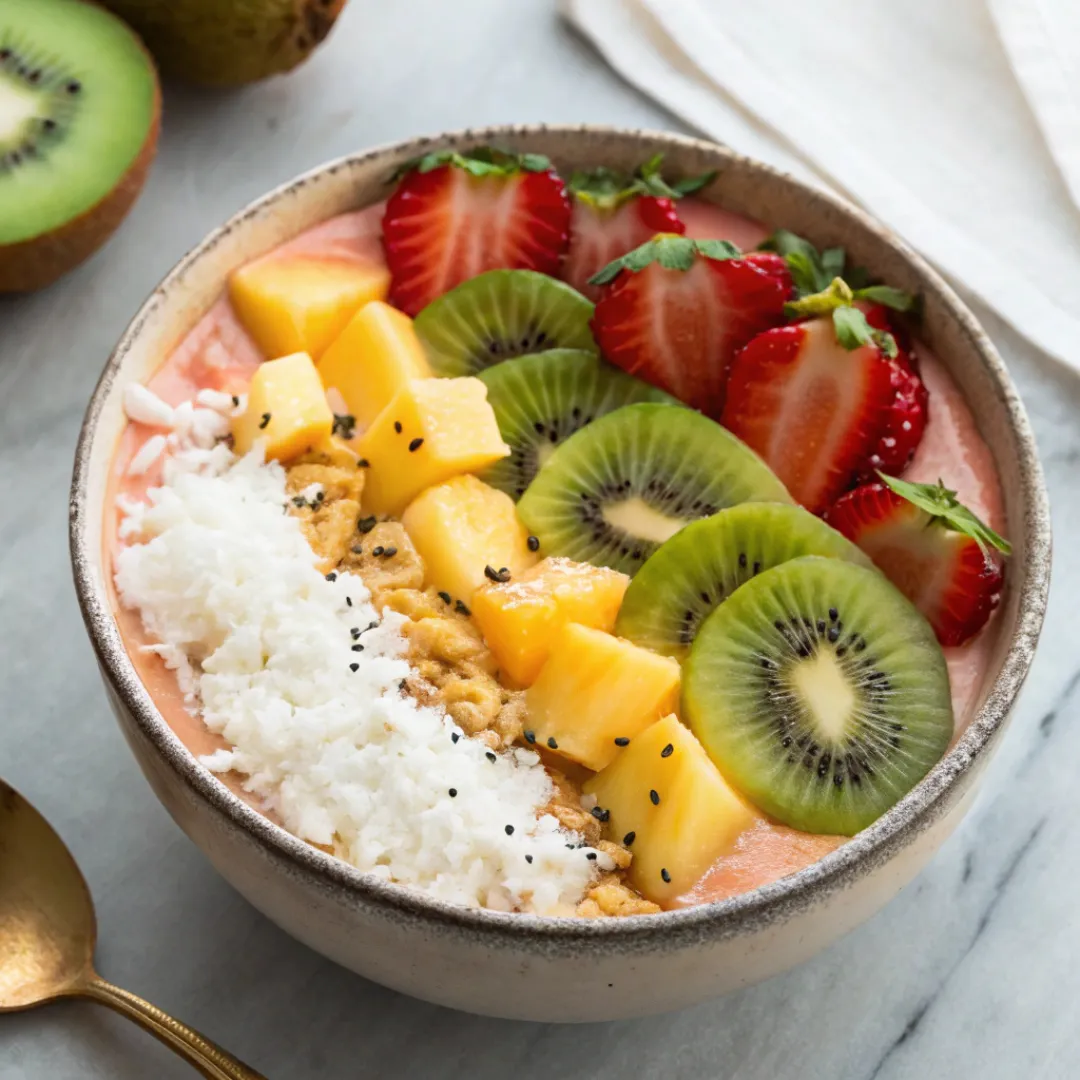Imagine starting your morning with a refreshing, vibrant tropical smoothie bowl that transports you to an island paradise with every spoonful. With a creamy blend of tropical fruits, delicious toppings, and a burst of natural flavors, a tropical smoothie bowl offers an energizing start to your day. Not only is it packed with essential nutrients, vitamins, and antioxidants, but it’s also incredibly versatile, allowing you to tailor it to your tastes and nutritional needs. This article dives into everything you need to know to make a perfect tropical smoothie bowl, from the ingredients and preparation to tips for customization, nutrition benefits, and creative topping ideas.
Whether you’re looking for a quick breakfast, a post-workout meal, or just a healthy treat, this tropical smoothie bowl will bring a taste of paradise to your kitchen. Let’s dive into the steps to make, customize, and enjoy this refreshing bowl!
What is a Tropical Smoothie Bowl?
A tropical smoothie bowl is a nutrient-dense, thick smoothie served in a bowl and eaten with a spoon. Unlike a traditional smoothie that is typically sipped, smoothie bowls have a thick texture achieved by using frozen fruits and minimal liquid, allowing for a spoonable consistency. This texture makes it perfect for adding a variety of toppings, which add both flavor and nutrients. Tropical smoothie bowls focus on ingredients like mango, pineapple, banana, and coconut milk, which provide a tropical flavor and bring a bright, colorful appeal.

Health Benefits of Tropical Smoothie Bowls
Tropical smoothie bowls are not only a treat for your taste buds but are also loaded with health benefits. Here’s a look at some of the advantages:
Boosts Immunity
Tropical fruits like mango and pineapple are rich in vitamin C, which supports the immune system.
Aids Digestion
Pineapple contains bromelain, an enzyme that helps in digestion, while bananas and other fruits provide fiber to keep your digestive system healthy.
Provides Sustained Energy
The natural sugars from fruits, combined with healthy fats and proteins, offer a balanced source of energy.
Rich in Antioxidants
Antioxidants found in tropical fruits help reduce inflammation and fight free radicals, which are linked to various diseases.
Supports Skin Health
Vitamin C and other antioxidants contribute to healthy skin, helping you maintain a youthful glow.
By adding nutrient-rich toppings and ingredients, you can easily create a breakfast bowl that meets various dietary needs, whether you’re focused on boosting energy, supporting digestion, or enhancing skin health.
Essential Ingredients for a Tropical Smoothie Bowl
Creating a delicious tropical smoothie bowl starts with selecting the right base ingredients. Here are the essentials:
- Frozen Mango Chunks: Mangoes add a natural sweetness and creamy texture.
- Frozen Pineapple: Pineapple brings a tangy sweetness that complements other tropical fruits.
- Banana: This provides creaminess, as well as natural sweetness and potassium.
- Coconut Milk or Coconut Water: For a creamy consistency and tropical flavor, coconut milk or water works best. Other plant-based milks like almond or cashew milk can also be used.
- Greek Yogurt (Optional): For extra creaminess and a protein boost, Greek yogurt is a great addition, though it can be left out for a dairy-free version.
Each ingredient offers its unique flavor and health benefits, creating a delicious and nutritious base.
Step-by-Step Recipe for a Tropical Smoothie Bowl
Ready to create your tropical smoothie bowl? Follow this easy recipe:

Ingredients
- 1 cup frozen mango chunks
- 1 cup frozen pineapple chunks
- 1 ripe banana, sliced
- ½ cup coconut milk (or coconut water for a lighter version)
- Optional: ¼ cup Greek yogurt for added creaminess
Instructions
- Prepare Ingredients: Use frozen mango and pineapple for a thick consistency. Peel and slice the banana.
- Blend Base: Add the mango, pineapple, banana, coconut milk, and Greek yogurt (if using) into a high-speed blender.
- Blend Smoothly: Blend on high until the mixture is smooth and creamy. Add a bit more coconut milk if necessary to reach the desired consistency.
- Serve: Pour the smoothie into a bowl and smooth out the top with a spoon.
This recipe yields one to two servings, making it perfect for sharing or meal-prepping.
Customizing Your Smoothie Bowl
One of the best aspects of smoothie bowls is how customizable they are. Here are some ways to adjust your tropical smoothie bowl:
Add Greens
A handful of spinach or kale can add extra nutrients without affecting the flavor.
Protein Boost
Add protein powder, hemp seeds, or a scoop of Greek yogurt for additional protein.
Superfoods
Mix in chia seeds, flaxseeds, or spirulina to add a nutrient boost.
Swap Fruits
Try using papaya, guava, or peach for a twist on the tropical base.
Customizing the ingredients allows you to create a smoothie bowl that meets your specific dietary needs and preferences.
Best Toppings for a Tropical Smoothie Bowl
Toppings are the fun part of making smoothie bowls, allowing you to add flavor, texture, and nutrition. Here are some popular toppings:
Fresh Sliced Fruits
Kiwi, banana, dragon fruit, or strawberries add extra sweetness and visual appeal.
Coconut Flakes
Adds a crunch and enhances the tropical theme.
Chia Seeds
Packed with omega-3s, fiber, and protein, chia seeds are a powerful nutritional addition.
Granola
Offers crunch and added fiber.
Nuts and Seeds
Almonds, cashews, or pumpkin seeds provide healthy fats and protein.
Edible Flowers
Hibiscus or pansies make a beautiful garnish.
Tips for Achieving the Perfect Texture
Smoothie bowls require a certain thickness to hold toppings without sinking. Here’s how to achieve that perfect texture:
Use Frozen Fruit
Frozen fruit gives your smoothie a thick, ice-cream-like consistency.
Limit Liquids
Start with a small amount of coconut milk and add more only if needed.
Blend in Pulses
If your blender struggles with thick ingredients, use the pulse option to prevent overheating.
High-Speed Blender
A powerful blender creates a smooth, creamy consistency quickly.
For more detailed tips on creating the perfect smoothie bowl, check out this guide from Olivia’s Kitchen.
Balancing Flavor and Nutrition
Creating a balanced tropical smoothie bowl is easy when you follow these tips:
Sweetness Control
If you prefer a sweeter bowl, add a bit of honey or dates, but natural fruit sugars are usually enough.
Balanced Nutrients
Aim for a mix of fruits, proteins, and healthy fats in your smoothie bowl.
Fiber and Protein
Adding chia seeds, flaxseeds, or yogurt increases fiber and protein, keeping you full longer.
Common Mistakes to Avoid
Here are some common mistakes to watch out for when making smoothie bowls:
Adding Too Much Liquid
This thins the bowl, making it more like a smoothie. Start with a small amount and gradually add more.
Overdoing Toppings
While toppings add flavor, too many can overwhelm the bowl’s flavor and add excess calories.
Using Fresh Fruit Only
Fresh fruit is great, but frozen fruit is key for a thick, spoonable consistency.
Ideal Times to Enjoy a Tropical Smoothie Bowl
While a tropical smoothie bowl is a popular breakfast, it can be enjoyed at different times:
Breakfast
Provides energy and nutrients for the day.
Post-Workout
A quick and easy post-exercise option for replenishing energy.
Afternoon Snack
A refreshing midday snack, especially in warmer weather.
Serving Ideas and Garnishes
Elevate your presentation with these creative serving ideas:
Colorful Layers
Arrange fruits and toppings in layers to create a visually appealing bowl.
Herbs for Garnish
Fresh mint or basil adds a pop of color and flavor.
Wide, Shallow Bowl
Using a shallow bowl gives more surface area for arranging toppings.
Enhancing Nutritional Value with Superfoods
Incorporate superfoods into your tropical smoothie bowl to maximize its nutritional value:
Chia Seeds
High in omega-3 fatty acids, fiber, and protein, chia seeds support heart health and digestion.
Hemp Seeds
Provide protein and omega-3s, as well as magnesium and iron.
Spirulina
A nutrient-dense blue-green algae that adds antioxidants and a protein boost.
These superfoods can be blended into the smoothie base or sprinkled on top, adding to the bowl’s nutritional benefits.
The Environmental Benefits of Eating More Fruits
Smoothie bowls not only benefit your health but also positively impact the environment. By choosing fresh, plant-based ingredients, you’re making a sustainable choice that helps reduce the demand for processed foods and animal products. Additionally, eating more fruits and plant-based ingredients helps lower greenhouse gas emissions while conserving water and land resources. Furthermore, supporting local and organic fruit farmers contributes to sustainable agriculture, reduces carbon emissions from long-distance transport, and often results in fresher, more flavorful fruits. In short, each smoothie bowl can be a delicious step towards a healthier planet.
Frequently Asked Questions
What is in a Tropical Smoothie acai bowl?
It typically includes a blend of acai berries with tropical fruits like mango, pineapple, and banana, topped with granola, coconut, fresh fruits, and seeds.
Do smoothie bowls have a lot of sugar?
They contain natural sugars from fruit. You can control sugar by using low-sugar fruits, unsweetened yogurt, and minimal sweeteners.
What makes a smoothie bowl thicker than a smoothie?
Using frozen fruits and minimal liquid creates a spoonable, thicker texture ideal for holding toppings.
What’s the difference between an acai bowl and a smoothie bowl?
An acai bowl specifically uses acai berries, while smoothie bowls use various fruits. Acai bowls have a unique, mildly tart flavor and are high in antioxidants.
Conclusion
A tropical smoothie bowl brings the vibrant flavors of the tropics into your daily routine, providing a refreshing, nutrient-packed breakfast or snack option. With creamy frozen fruits, customizable toppings, and endless ways to adjust the ingredients, you can make a tropical smoothie bowl that’s uniquely yours. Not only does it taste like a tropical getaway in a bowl, but it also offers a variety of health benefits, from boosting immunity to supporting digestion and providing a sustained energy source.
So, grab your blender and create your own tropical paradise – a smoothie bowl that’s delicious, nutritious, and just what you need for a fresh start!

